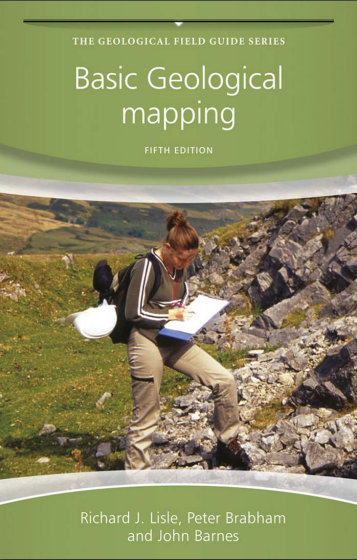Basic Geological Mapping
FIFTH EDITION
by Richard J. Lisle
School of Earth and Ocean Sciences, Cardiff University
Peter J. Brabham ,School of Earth and Ocean Sciences, Cardiff University
and
John W. Barnes
 |
| Basic Geological Mapping |
Content of the Book
Introduction
1
1.1 Outline and Approach..............1
1
1.2 Safety ....................................2
2
1.3 Field Behavior.........................3
4
1.4 A Few Words of Comfort................................................... .............................5
Field Equipment
6 2.1 Hammers and Chisels ......................................................................................7
6
2.2 Compasses and Clinometers ............................................................................8
8
2.3 Hand Lenses ....................................................................................................9
13
2.4 Tapes ............................................................................................................10
14
2.5 Map Cases.....................................................................................................11
14
2.6 Field Notebooks ............................................................................................12
15
2.7 Scales ...........................................................................................................13
16
2.8 Protractors ........................................................................14
16
2.9 Pencils, Erasers and Mapping Pens ..................................15
17
2.10 Acid Bottles ....................................................................16
18 2.11 Global Positioning System (GPS) and Mobile Phones... 17
19
2.12 Other Instruments ............................................................18
23
2.13 Field Clothing 26
Topographic Base Maps
3.1 Types of Geological Map 27
3.2 Topographic Base Maps 29
3.3 Geographic Coordinates and Metric Grids 30
3.4 Grid Magnetic Angle 33
3.5 Position Finding on Maps 34
3.6 Use of Air Photography as a Mapping Tool 43
3.7 Suitability of Images for Geological Mapping 48
Methods of Geological Mapping
4.1 Strategy for the Mapping Programme 50
4.2 Mapping by Following Contacts 51
4.3 Traversing 52
4.4 Exposure Mapping 55
4.5 Mapping in Poorly Exposed Regions 57
4.6 Superficial Deposits 62
4.7 Drilling 66
4.8 Geophysical Aids to Mapping 67
4.9 Large-Scale Maps of Limited Areas 71
4.10 Underground Mapping 74
4.11 Photogeology
Technological Aids to Mapping
5.1 Digital Terrain Models 80
5.2 Topographic Surveying Techniques 86
6 Field Measurements and Techniques 95
6.1 Measuring Strike and Dip of Planar Structures 95
6.2 Plotting Strike and Dip 101
6.3 Recording Strike and Dip 101
6.4 Measuring Linear Features 102
6.5 Folds 105
6.6 Faults 110
6.7 Thrusts 112
6.8 Joints 112
6.9 Unconformities 114
6.10 Map Symbols 114
6.11 Specimen Collecting 116
6.12 Field Photography 118
6.13 Panning 124
Mappable Rock Units and Lithology
7.1 Lithostratigraphy and Sedimentary Rocks 126
7.2 Sedimentary Formations 127
7.3 Rock Descriptions 128
7.4 Identifying and Naming Rocks in
the Field 129
7.5 Fossils 133
7.6 Phaneritic Igneous Rocks 134
7.7 Aphanitic Igneous Rocks 135
7.8 Veins and Pegmatites 135
7.9 Igneous Rocks in General 136
vi
CONTENTS
7.10 Pyroclastic Rocks 138
7.11 Metamorphic Rocks 138
7.12 Economic Geology 140
Field Maps and Field Notebooks
8.1 Field Maps 146
8.2 Field Notebooks 154
Fair Copy Maps and Other Illustrations
9.1 Fair Copy Maps 162
9.2 Transferring Topography 163
9.3 Transferring Geology 163
9.4 Lettering and Symbols 164
9.5 Formation Letters 165
9.6 Layout 165
9.7 Colouring 167
9.8 Stratigraphic Column 167
9.9 Overlays 168
9.10 Computer Drafting of the Fair Copy Map 169
Cross-Sections and 3D Illustrations
10.1 Cross-Sections 171
10.2 Method of Apparent Dips 175
10.3 Down-Plunge Projection Method 177
10.4 Balanced Cross-Sections 179
10.5 Columnar Sections 179
10.6 Block Diagrams 180
10.7 Models 183
Geological Reports
11.1 Preparation 186
11.2 Revising and Editing 186
11.3 Layout 186
11.4 The ‘Introduction’ 188
11.5 Main Body of the Report 188
11.6 The ‘Conclusions’ Section 191
11.7 Text Illustrations 191
11.8 References 192
11.9 Appendices 193
11.10 Some Final Thoughts 193
Appendix
Appendix A: Adjustment of a Closed Compass Traverse 195
Appendix B: Field Equipment Checklist 197
Appendix C: Indicators of Stratigraphical Way-Up 202
Appendix D: Useful Chart and Tables 203
References 205
Index 209
Download Link



1 comment:
Thanks so much
Post a Comment